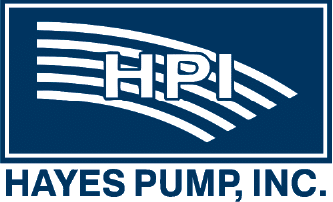Home » Blog » Tackling Tough Flows: A Deep Dive into Solids Handling Pumps
Tackling Tough Flows: A Deep Dive into Solids Handling Pumps
-Aug-18-2025-01-14-52-9048-PM.png?width=2000&height=1046&name=Hayes%20Pump%20Blog%20Featured%20Image%20(2)-Aug-18-2025-01-14-52-9048-PM.png)
In many industrial processes, the fluids being moved are far from pristine. From municipal wastewater and industrial slurries to mining tailings and food processing byproducts, dealing with liquids laden with solids is a common challenge. This is where solids handling pumps become essential. At Hayes Group, we specialize in providing reliable pumping solutions that can stand up to the toughest solid-laden applications.
Impeller Design: The Heart of Solids Handling
The ability of a pump to effectively handle solids is largely determined by its impeller design. Unlike pumps designed for clean water, solids handling pump impellers are engineered to minimize clogging and wear from abrasive or fibrous materials.
Solids handling pumps are rated based on their ability to pass spherical solids – a standard measure of the maximum diameter of a solid particle that can pass through the pump without obstruction. For example, a pump rated for 3-inch spherical solids can handle spherical objects up to 3 inches in diameter. This rating is critical for selecting a pump that matches the demands of your application, ensuring that debris like rocks, sludge, or organic matter can pass through without issue.
Two Key Impeller Types for Solids Handling
For applications involving solids, two primary impeller designs dominate:
- Semi-Open Impeller: This impeller type features vanes that are open on one side (typically the suction side) and backed by a shroud on the other. The semi-open design allows for relatively large clearances between the impeller vanes and the casing, which helps prevent solids from lodging and causing clogs. They offer a good balance of solids handling capability and efficiency, making them versatile for a range of applications with suspended solids and some fibrous materials.
- Enclosed 2-Vane Impeller: This design typically features two robust, wide vanes, creating large, unobstructed passageways. While enclosed, the wide spacing of the vanes significantly reduces the chance of clogging by large or stringy solids. These impellers are often favored for severe solids handling applications, such as raw sewage or heavy industrial slurries, where maximum solids passage is critical.
At Hayes Group, we understand that selecting a pump with the right impeller design is critical to optimizing performance and reliability in solids handling applications. Whether your operation demands the versatility of a semi-open impeller or the robust, clog-resistant capabilities of an enclosed 2-vane design, our team brings deep expertise and tailored solutions to every challenge.
Cross-Sectional Area of Impeller Passageways
A critical aspect of impeller design for solids handling is the cross-sectional area of the impeller passageways. These are the open spaces between the impeller vanes through which the fluid and solids travel. For effective solids handling, these passageways must be generous and unobstructed. Impellers with fewer vanes and wider openings maximize this cross-sectional area, creating a less tortuous path for solids and significantly reducing the risk of clogging, even with large or stringy debris.
Efficiency versus Solids Handling Trade-Off
Choosing a solids handling pump often involves a crucial trade-off: efficiency versus solids handling capability. Pumps designed to handle larger solids tend to be less hydraulically efficient than those designed for clean water.
Pump hydraulic efficiency is a measure of how effectively the pump converts the input mechanical energy into fluid energy. This fluid energy is represented by both the discharge pressure (the pressure at the pump's outlet, which isolates the downstream system from the pump's suction) and the suction pressure (the pressure at the pump's inlet, which influences how easily fluid enters the pump).
In a pump designed for maximum solids handling, the impeller passageways are wider and less restrictive to allow solids to pass. This design, while excellent for preventing clogs, creates more turbulence and less efficient conversion of velocity into pressure, leading to lower hydraulic efficiency compared to a clean-water pump with tightly designed, numerous vanes. When Hayes Group determines the best solids handling pump for your application, the balance between the needs for solids passage and desired energy efficiency is carefully considered.
The Critical Role of Clearances
Beyond impeller design, the clearances within a solids handling pump are paramount for its ability to pass solids and ensure long-term reliability. Clearances refer to the small gaps and spaces between the rotating impeller and stationary components like the pump casing or wear plate.
These clearances are crucial for movement within the pump, allowing the impeller to spin freely without contacting stationary parts, which would cause wear and potential damage. However, in solids handling pumps, these clearances are intentionally made larger than in clean water pumps.
The clearance between the impeller and casing in solids handling pumps is a critical factor governing efficiency, especially when large solids break down into smaller fragments upon entering or within the pump. When substantial solids, often encountered in municipal wastewater or industrial slurry applications, are subjected to the high-shear forces and impacts inside the pumps, they can fracture into numerous smaller, often abrasive, pieces. Despite having large clearance to avoid clogs from sizable solids, these fragmented pieces can become caught up in the smaller recesses of the pump, causing a reduction in performance and efficiency as well as wearing down the pump components.
Furthermore, these larger ports, designed to accommodate big solids, require higher flows to maintain sufficient velocity and pressure within the pump. If the flow rate is too low for the size of the pump and its clearances, solids can settle out, leading to accumulation and eventual clogging, despite the pump's solids-handling design. This is a key consideration when sizing a solids handling pump, ensuring adequate flow is maintained. The experts at Hayes Group are eager to help you determine the appropriate design to meet your needs.
Conclusion
Solids handling pumps are indispensable components in numerous industrial sectors, engineered to conquer the challenges of moving fluid laden with various types of solid material. From the careful selection of impeller design – be it a semi-open or a non-clog 2-vane, with their optimized cross-sectional passageways – to understanding the inherent trade-offs between efficiency and solids passage, every aspect is critical.
The strategic design of clearances is also vital, directly impacting a pump's ability to process large solids without interruption. At Hayes Group, we are committed to helping you navigate these complexities, offering expert advice and a range of high-performance solids handling pumps specifically engineered to keep your operations flowing smoothly, even in the most demanding conditions. Contact us today to discuss your specific solids handling needs and find the perfect pumping solution. And be sure to check out our manufacturing partners, products, and other blogs!



